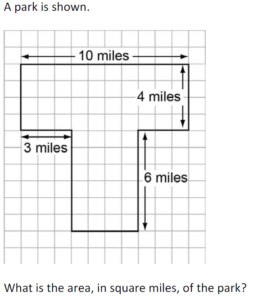Relate area to the operations of multiplication and addition.
c. Use tiling to show in a concrete case that the area of a rectangle with whole-number side lengths a and b + c is the sum of a x b and a x c. Use area models to represent the distributive property in mathematical reasoning.
d. Recognize area as additive. Find areas of rectilinear figures by decomposing them into non-overlapping rectangles and adding the areas of the non-overlapping parts, applying this technique to solve real world problems.
[divider] [/divider] Students are able to…
- Use an area model to represent the distributive property.
- Create rectangles to model the concept of area and how to use multiplication to determine the area.
- Decompose a rectangular figure into parts, find the area of each part and then combine parts for the total area.
- Solve word problems with rectilinear figures.
[divider] [/divider] Students are able to…because teachers:
- Provide opportunities for students to use color tiles to build an array, use the distributive property to decompose the shape and then add together to determine the total area.
- Model precise vocabulary: distributive property, area, square unit, tiling, length, width, and rectilinear.
- Pose tasks and questions where students must use their understanding of area, distributive property and concept of area being additive to solve problems.
[divider] [/divider] Questions to ask students:
- Why did you decide to decompose/break apart your shape that way?
- Sample answer that indicates understanding: I broke apart the shape into smaller rectangles to make it easier to find the area. I can count the squares or multiply the number of rows by the number of columns to easily find the area of the smaller rectangles and then add those areas together to get the area of the original larger shape.
- How will you use the smaller rectangles to find the total area?
- I will find the area of each rectangle and then add them together to find the total area.
- How does your model help you determine the area?
- Sample answer that indicates understanding: I can use the array made with color tiles or drawn on graph paper to break apart my shape. I can push apart the color tiles or draw a line to divide the shape on the graph paper, and then find the area of the new, smaller rectangles.
[divider] [/divider] FSA Notes
Cognitive Complexity Level: 3 – Strategic Thinking and Complex Reasoning
Achievement Level Descriptors:
2- [intentionally left blank]
3- finds the area of a rectangle by tiling and shows that the area of a rectangle found when tiling is the same as would be found by multiplying the side lengths; multiplies the side lengths of a rectangle composed of two rectangles and uses the distributive property to find the overall are
4- finds areas of rectangles by multiplying the side lengths in the context of solving realworld problems; decomposes a rectilinear figure into multiple rectangular parts and finds the area of the new rectangles
5- creates area models to represent the distributive property for area of a rectangle
Assessment Limits:
Figures are limited to rectangles and shapes that can be decomposed into rectangles.
Dimensions of figures are limited to whole numbers.
All values in items may not exceed whole number multiplication facts of 10 × 10.
[divider] [/divider] Additional Resources:
Additional in depth content knowledge
Blog Post: Top 5 Things to Know About Using Arrays to Model Multiplication and Division
LearnZillion Videos:
Find the Area of Rectangles Using Arrays
Find Area Using Multiplication
Khan Academy: Decompose Shapes to Find Area
[divider] [/divider] Sample Formative Assessment Task:
[divider] [/divider] Resources/Tasks to Help your Child at Home:
Present your child with drawings of rectangles or rectilinear figures on graph paper and challenge him or her to draw a line showing how they would break apart the shape into smaller rectangles and then use those smaller rectangles to find the area of the larger figure.
LearnZillion Videos:
Find the Area of Rectangles Using Arrays
Find Area Using Multiplication
Khan Academy: Decompose Shapes to Find Area

